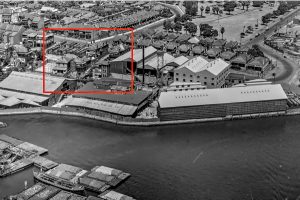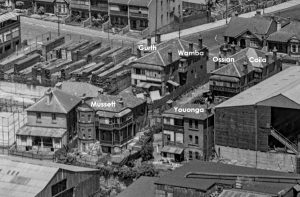By Rodney Hammett, Bulletin 3/2024, May

Who remembers the houses that once stood at the corner of Glebe Point Road and Mary Street? Demolished in the 1970s, they occupied part of the space that is now No. 451 Glebe Point Road – The Anchorage. The 1939 map of Glebe (Figure 1) shows a tennis court on the corner of Mary Street which belonged to the house in front of it, originally named Cliff Lodge and later The Anchorage. Lyn Collingwood’s article in Bulletin 05/2017 discussed its history and the people who lived there.
This is the first part of an article on the history of the houses, the developer/builder and people who lived in the houses within the shaded area of Figure 1.
Fortunately, there is an aerial photograph taken in the 1940s which shows the then development in this area, including the fading grandeur of the quite amazing four houses that had been built here in the late 1880s. See Figures 2 and 3.
On Glebe Point Road there were two large buildings of similar construction, each divided into two dwellings. These were Nos. 453 and 455 (Gurth and Wamba) and Nos. 457 and 459 (Ossian and Coila). Closer to Johnstons Bay and with access to Glebe Point Road between the previously mentioned houses, was Mussett (No. 455a) and Youonga (No. 457b). These four houses were built on Lots 38 and 39 of the Mary Chisholm Estate which had been sold as vacant land in the early 1880s.1 Next door was Cliff Lodge with its tennis court and spacious grounds, built on Lots 22 and 23 of the same subdivision.

The first purchasers of Lots 38 and 39 have not yet been established; however, in February 1887 when the reclaimed land on Johnstons Bay in front of Lot 39 was purchased from the Crown for £50, Robert Buik Edward was the buyer because he owned Lot 39.2 He likewise purchased the land in front of Lot 38, in July 1888. Robert Edwards was a postmaster and a man of enterprise who also purchased land on Louisa Road Birchgrove and in Eglinton Road Glebe. In Eglinton Road, he arranged the construction of the row of terraces Nos. 4–40. These were the subject of The Eglinton Road Project by members of The Glebe Society in 2011–2012.

Gurth–Wamba and Ossian–Celia on Glebe Point Road were occupied from 1888, with the two closer to the bay being occupied from 1890.
A photo from Bulletin 06/2011 shows labourers and Robert Edward in front of a partially completed house with a completed house to the left. Close examination of Figures 3 and 4 confirms these men are standing in front of Gurth–Wamba (under construction) while Ossian–Celia is the other house. Robert Edward is the person on the right of this group. The photo must have been taken in about 1887.
Robert Edward moved into the completed Ossian in 1888. He was 41 with a wife (Mary) and three daughters. At this time, he was a senior clerk in the head office of the Postmaster General, Sydney, on a salary of £340. Despite this full-time job, Robert was able to spend time with the labourers building his houses, as evidenced by Figure 4.
Robert was the son of a stonemason, born in Scotland. His parents, with four children, migrated to New South Wales, arriving in January 1853. The family lived at Maze St Darlington (now demolished and under the School of Engineering at Sydney University) and his father, David Barnett Edward, served as an alderman on the Darlington Municipal Council from 1878 to 1880. Robert was the third child and eldest son with six siblings. Aged 20 in 1868, he joined the Public Service as a clerk in the Department of Postmaster-General’s. Robert and Scottish-born Mary (neé Gardiner) married at Forest Lodge in 1877. Their children were Mary Elizabeth (1879–1966), Jessie Dewar (1883–1950) and Annie Isabella (1884–1977). So, in 1888, these girls would have been aged 9, 5 and 4 respectively, and presumably two of them attended the Glebe Public School.
In 1891, Robert was appointed as the postmaster to the Post Office in William Street Darlinghurst. Here there were living quarters attached. This means they left Glebe and did not return to Glebe to live until after Robert retired from his William Street role in 1908. He was then aged 60. Mary had died in 1896 at Darlinghurst. However, Robert married again in 1903, to widow Mary Ann Taylor (neé Hauxwell) who hailed from Yorkshire, England, but was living in Sydney. The family moved into Gurth when they returned to Glebe, later moving to Mussett in about 1915.

The land in Eglinton Road was purchased in 1908. The single storey three bedroom terraced housing which overlooked a new park began to be occupied from 1909. Robert was nearby to oversee its construction. Nos. 4-10, Nos. 12-22 and Nos. 26-28 were sold to separate investors who put in tenants. Robert retained ownership of No. 24 and Nos. 30-40 while he was alive, from which he would have received rental income. Following his death in 1932, they were retained by his daughters, two of whom by then were married: Annie in 1907 to Reginald Bishop Henville and Mary in 1917 to Thomas Ralph Coulson. Jessie did not marry.
Robert and his wife Mary moved from Mussett to 18 Boyce Street in 1925, at the time D Hardy and Sons, timber merchants, were expanding their business on the eastern side of Glebe Point Road. D Hardy and Sons started purchasing land at The Point in 1915 and it was only when Robert’s houses were surrounded (see Figures 1 and 2) that he too sold them, in November 1923. The 1949 aerial photograph (available at the City of Sydney’s ‘Historical Atlas’) shows that all houses still existed at that time.
Parkes Developments purchased this land at The Point from D Hardy and Sons in the 1960s. They also purchased the land around Bellevue Cottage from other timber merchants who were moving their businesses away from the Glebe foreshore. The 1970s apartments on, and near, the waterfront we see now, are the product of Parkes’ redevelopment of the waterfront. The Bulletin of 09/1975 has an interesting and unflattering account of Parkes Developments and their Glebe developments. There it is reported that the houses built by Robert Edward were probably demolished in 1973.
The next part of this story will discuss some of the tenants who lived in these houses.
Acknowledgement: Thank you to Genny Kang, a member of the Eglinton Road Project, who first piqued my interest, some years ago now, when she gave me a photo of Robert Edward sitting with family in a garden in front of a substantial house. She said the house was one of those demolished to make way for The Anchorage units, and I might like to find out some of their history. Genny, I believe this is the story you might have been hoping for. That photo will be included in the next part of this story.
Notes: 1 NSW Land Registry Service; Vol 150 Fol 184 & DP 100; 2 NSW Land Registry Service; Vol 827 Fol 12









There are no comments yet. Please leave yours.